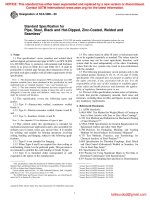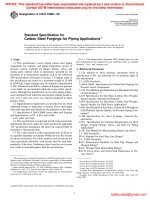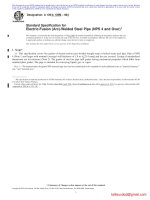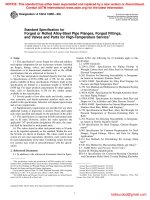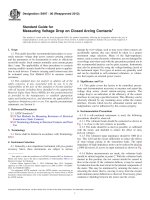Astm f 497 00 (2004)
Bạn đang xem bản rút gọn của tài liệu. Xem và tải ngay bản đầy đủ của tài liệu tại đây (60.82 KB, 3 trang )
Designation: F 497 – 00 (Reapproved 2004)
Standard Practice for
Use of the Electric and Electronic Typewriter as a Test
Instrument1
This standard is issued under the fixed designation F 497; the number immediately following the designation indicates the year of
original adoption or, in the case of revision, the year of last revision. A number in parentheses indicates the year of last reapproval. A
superscript epsilon (e) indicates an editorial change since the last revision or reapproval.
PH 2.36 Terms, Symbols, and Notation for Optical Transmission and Reflections Measurements3
PH2.17 Density Measurements—Geometric Conditions for
Reflection Density3
PH2.18 Density Measurements—Spectral Conditions3
1. Scope
1.1 This practice covers standardized procedures utilizing
the electric or electronic typewriter as an imaging device for
measuring the performance properties of carbonless paper,
carbon paper, inked ribbon, and similar image producing
products.
3. Terminology
3.1 Definitions:
3.1.1 For definitions of terms used in this practice, refer to
Terminology E 284, F 221, F 549, and F 909.
NOTE 1—Electric and electronic typewriters covered by this practice
have a full-character type element. Examples of such elements are type
bar, ball, thimble, and daisy wheel.
1.2 This standard does not purport to address all of the
safety concerns, if any, associated with its use. It is the
responsibility of the user of this standard to establish appropriate safety and health practices and determine the applicability of regulatory limitations prior to use.
4. Summary of Practice
4.1 This practice consists of using an electric or electronic
typewriter under specified conditions to produce images for the
evaluation of carbon paper, carbonless paper, inked ribbon, and
paper manifold sets on a comparative basis.
2. Referenced Documents
2.1 ASTM Standards: 2
D 685 Practice for Conditioning Paper and Paper Products
for Testing
D 3460 Specification for White Watermarked and Unwatermarked Bond, Mimeo, Spirit Duplicator, Reprographic and
Laser Printer Cut-Sized Office Papers
E 284 Terminology of Appearance
F 221 Terminology Relating to Carbon Paper and Inked
Ribbon Products and Images Made Therefrom
F 549 Terminology Relating to Carbonless Copy Products
F 909 Terminology Relating to Printers
F 1125 Terminology of Image Quality in Impact Printing
Systems
2.2 ANSI Standard:
5. Significance and Use
5.1 This practice is intended to provide a means of rapid
evaluation of comparative image quality relative to carbon
paper, carbonless paper, inked ribbons, and similar imageproducing products.
6. Interferences
6.1 Many electric and electronic typewriters are subject to
type impact variations due to fluctuations of line voltage.
Voltage stabilizing devices, recommended by the typewriter
manufacturer, can be used. If a stabilizing device is not used,
tests should be run at periods when the line load is low or
stabilized.
6.2 The densitometer readings will also vary with voltage
fluctuations. The same precautions as in 6.1 should be taken.
6.3 In densitometer readings care should be taken not to
confuse width of line with intensity.
6.4 Fluctuations of temperature and humidity will affect the
paper used for image reception. Tests run on different days
1
This practice is under the jurisdiction of ASTM Committee F05 on Business
Imaging Products and is the direct responsibility of Subcommittee F05.02 on Inked
Transfer Imaging Products.
Current edition approved Dec. 1, 2004. Published December 2004. Originally
approved in 1985. Last previous edition approved in 2000 as F 497 – 00.
2
For referenced ASTM standards, visit the ASTM website, www.astm.org, or
contact ASTM Customer Service at For Annual Book of ASTM
Standards volume information, refer to the standard’s Document Summary page on
the ASTM website.
3
Available from American National Standards Institute, 25 W. 43rd St., 4th
Floor, New York, NY 10036.
Copyright © ASTM International, 100 Barr Harbor Drive, PO Box C700, West Conshohocken, PA 19428-2959, United States.
1
F 497 – 00 (2004)
11.6 For control purposes, produce identical image and test
patterns in accordance with 11.1-11.5 with control materials.
When ribbons are being tested, produce identical images and
test patterns in accordance with 11.1-11.5 with a fresh control
ribbon on the same test sheet. When paper or forms are being
evaluated, retain the same ribbon and replace the test paper or
forms with control materials.
could show variations in results. All tests should be dated and
temperature and relative humidity during the tests recorded.
7. Apparatus
7.1 Typewriters, to be used to prepare images. An electric or
electronic typewriter in normal use for the application and
adjusted to the manufacturer’s specifications.
7.2 Reflection Densitometer, meeting the geometric conditions of PH2.17 and the spectral conditions of PH2.18, and
measuring reflection density as defined in ANSI PH 2.36. The
aperture diameter of the instrument shall not be less than the
line spacing of the typewriter.
12. Procedure for Rapid Evaluation for Comparative
Image Quality
12.1 Visual Means:
12.1.1 Visually compare the test and control product images. Use Terminology F 1125 as a guide in identifying and
describing the following defects:
12.1.1.1 Character spread,
12.1.1.2 Edge definition,
12.1.1.3 Extraneous ink and spatter,
12.1.1.4 Fill-in,
12.1.1.5 Over-strike,
12.1.1.6 Visual density,
12.1.1.7 Voids or broken characters, and
12.1.1.8 Manifolding Performance—Comparative quality
of images on corresponding copies of multipart forms.
12.2 Reflection Density:
12.2.1 Calibration— The densitometer should be calibrated
in accordance with PH2.17 and PH2.18.
12.2.2 Place the image test specimen on a backing such as
a stack of paper of the same color, weight, and reflectance as
the test specimen. This backing should be opaque and the
addition of more sheets or thickness to the backing should not
change its reflection density.
12.2.3 Place the test specimen (on the backing) under the
viewing head of the instrument and read the reflection density
obtained on the specimen. Readings should be taken randomly
from five or more different areas of the imaged material.
Record the readings and compute the average density.
8. Materials
8.1 White bond paper, conforming to Specification D 3460,
Grade Number 4, unwatermarked, basis weight 20 lb (75 g/m
2 g).
9. Calibration and Standardization of Typewriter
9.1 Select upper case “6,” “B,” or “&” characters. Clean the
type face of the characters selected for the test. Adjust the
impact pressure, if possible, until slight embossment is produced on the back of a single sheet of 20 lb (75 g/m2 g) bond
paper. Reduce impact pressure until embossment just disappears. If impact pressure cannot be so adjusted due to the
typewriter design, use a nominal impact setting.
9.2 For reflection density test, a specially fitted two or
three-line grid may be used in some typewriters.
10. Conditioning
10.1 Conduct testing in an environment with stable conditions of temperature and relative humidity. It is suggested that
the test material (white paper, carbon paper, ribbons, and
manifold sets) be conditioned for 24 h in the area in which the
test will be conducted. If available, standard conditions 50.0 6
2.0 % relative humidity and 23.0 6 1.0°C (73.4 6 1.8°F)
should be used, as given in Practice D 685.
11. Procedure for Preparing Image
11.1 Insert the test ribbon (fabric or film) in the typewriter
in the normal manner. For one time single-strike ribbons, each
character type face must strike each time on an unused portion
of the ribbon (no overstrike). Test and control ribbons must
feed in the same direction.
11.2 Insert the paper or manifold set in the normal manner,
but avoid typing on watermarks or imperfections in the paper.
11.3 Adjust the bail rolls to hold the paper against the
platen, one on each side of the paper, but away from the area
where the pattern is to be produced.
11.4 Operate the typewriter at a constant speed to produce
the desire test pattern. If no test pattern is otherwise specified,
a general purpose one consists of ten lines of ten or more
characters each typed in a block, centered on the paper or other
test material.
11.5 Remove the test paper, carbon paper, or paper sets
upon which the test pattern has been produced, being careful to
avoid any smudging of the pattern.
13. Report
13.1 Report the visual observations of the test product
images as compared to the control product images for the
properties in 12.1.1.1-12.1.1.8.
13.2 Reflection density if determined in 12.2.
14. Precision
14.1 This practice will provide repeatable ranking order
results of repeatable relationship to a control within a laboratory.
14.2 Ranking order and comparative results may not necessarily be reproduced between laboratories because of differences in operators, typewriters, typewriter actions, and ambient
conditions.
15. Keywords
15.1 electric typewriter; electronic typewriter; image quality
2
F 497 – 00 (2004)
ASTM International takes no position respecting the validity of any patent rights asserted in connection with any item mentioned
in this standard. Users of this standard are expressly advised that determination of the validity of any such patent rights, and the risk
of infringement of such rights, are entirely their own responsibility.
This standard is subject to revision at any time by the responsible technical committee and must be reviewed every five years and
if not revised, either reapproved or withdrawn. Your comments are invited either for revision of this standard or for additional standards
and should be addressed to ASTM International Headquarters. Your comments will receive careful consideration at a meeting of the
responsible technical committee, which you may attend. If you feel that your comments have not received a fair hearing you should
make your views known to the ASTM Committee on Standards, at the address shown below.
This standard is copyrighted by ASTM International, 100 Barr Harbor Drive, PO Box C700, West Conshohocken, PA 19428-2959,
United States. Individual reprints (single or multiple copies) of this standard may be obtained by contacting ASTM at the above
address or at 610-832-9585 (phone), 610-832-9555 (fax), or (e-mail); or through the ASTM website
(www.astm.org).
3

